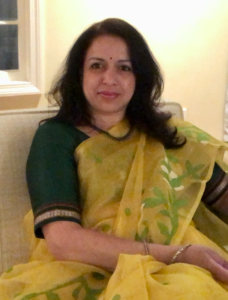By Sonali Tambe
WESTON, MA–The LearnQuest Music Academy, a pillar in the Greater Boston community for advancing Indian Classical music, inaugurated its 16th annual music festival over the weekend starting March 29th. This music conference, notable for showcasing the rich diversity of Indian music continued the tradition with a remarkable lineup of both Carnatic and Hindustani music disciplines.
One of the highlights of the opening weekend was a performance by Dhrupad maestro Pandit Uday Bhavalkar. Drupad style of music, which preceded Khayal gayaki, is the oldest form of musical tradition heard today. Characterized by the importance on purity of sound and resonance, precise and disciplined execution and graceful structure, Dhrupad has a meditative quality.
A primary attribute of Dhrupad music lies in its balanced emphasis on both the free exploration and development of a raag and the structured composition within rhythmic confines. Each Dhrupad performance initiates with an anibaddha (unbound by a specific taal) section with in-depth alap in a nom-tom format, delving into the essence, mood, and nuances of the raag. Following this, the performance transitions into the nibaddha (structured or bound by a well-defined taal) phase—a composition anchored in a specific rhythmic cycle.
In doing so, Dhrupad artfully marries melody and rhythm, catering to the listener’s appreciation for both the intricate beauty of the raag and its dynamic expression through rhythm.
The audience awaited with bated breath for Udayji’s performance even after a busy day of musical festivities at the Casey Theatre of Regis College. Panditji took the stage accompanied by Sukhad Munde on pakhawaj and Kirit Singh on vocal support. He announced the commencement of the performance with raag Darbari and started with unhurried exposition of notes in the mandra saptak (lower octave).

The soft and slow invocation of Sa, adorned with a delicate glide, conjured the ethereal image of light slowly suffusing the sacred chamber of a temple at the moment of illumination. Even without any instrumental accompaniment except a taanpura, his slow, meditative aalapchari evoked a sense of serenity in the audience. The slow exploration over the entire madhya saptak transitioned to jod and jhala.
The anibaddha section of the Dhrupad presentation itself is in three parts – aalap, jod and jhala. The jod marks a rhythmic but still unpulsed increase in tempo, leading to the jhala, which introduces a more rhythmic articulation of notes. In these three sections, utmost importance is given to the purity of notes and raag.
As each of these three sections progressed, Udayji revealed intricacies and beauty of Darbari. Utilizing the nuances of meend, gamak, kan swar, and aandolan, he illuminated the intrinsic beauty within each swara. In his performance, each note was handled tenderly, like a precious gemstone, with every turn revealing another dazzling aspect of its beauty, much like admiring a diamond from different angles to appreciate its brilliance. Varied facets of each note were revealed with each turn of his melodic phrasing. On stage, his gaze seemed to trace the luminous trajectory of the swaras, beckoning the spectators to partake in the beauty he was beholding.
His command over the microtonal subtleties crucial to Darbari was nothing short of extraordinary. The expressions of the ati-komal gandhar and dhaivat in the lower octave were executed with such exquisite precision and emotive potency that they effortlessly stirred the soul. Note by note the majestic nature of Darbari was being unfurled for the audience which then transitioned into the nibaddha part of the presentation.
Udayji started a traditional composition set to a 12-beat cycle of Chautaal. This relatively shorter section of the presentation is structured and follows a strict sequential pattern. The elegance and precision of the layakari were truly delightful. The skillful use of atit and anaagat (a deliberate deviation from the sam or the first beat of the cycle) added an element of surprise.
In the realm of Dhrupad, the intricate taals contribute to the genre’s contemplative and sweeping ambiance. Sukhad Munde’s skill in melding melody with rhythm was displayed with notable finesse. The interplay between the pakhawaj and Udayji’s vocal expression, marked not by competition but by harmonious conversation, enriched the performance’s tranquil allure. Kirit Singh’s vocal support was equally noteworthy. He supported and enhanced the melody when appropriate. Rooted in the distinguished lineage of Dagar bani, Udayji’s interpretation of Dhrupad is marked by an eloquent simplicity and impeccable intonation. In his performance, the profound depths of raag Darbari were conveyed with a deceptive ease that belied the complexity beneath, offering the audience a regal and immersive musical experience.
Dhrupad stands as a testament of spiritual and philosophical depth of Indian classical music. Pandit Uday Bhavalkar, a leading exponent of Dhrupad genre, transcends mere performance; he is akin to a sage traversing the profound musical landscape of Dhrupad gayaki. His personality appears to encapsulate the meditative and spiritual essence of this venerable musical form.

His protégé Kirit Singh and accompanist Sukhad Munde display a temperament that echoes his own—gentle in manner and soft in speech. Darbari was followed by a Dhamar as is the usual convention. Stylistically similar to dhrupad, Dhamar offers a lighter musical experience. Panditji sang a Hori in raag Bhairavi and concluded the performance to a standing ovation by an audience who was moved to tears. LearnQuest deserves high praise for curating a series of stellar performances that grace the cultural landscape of New England.














